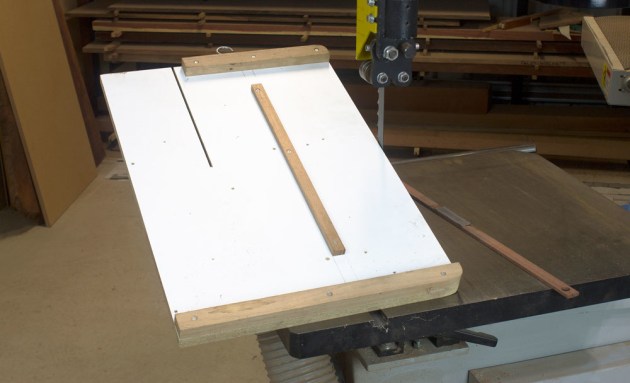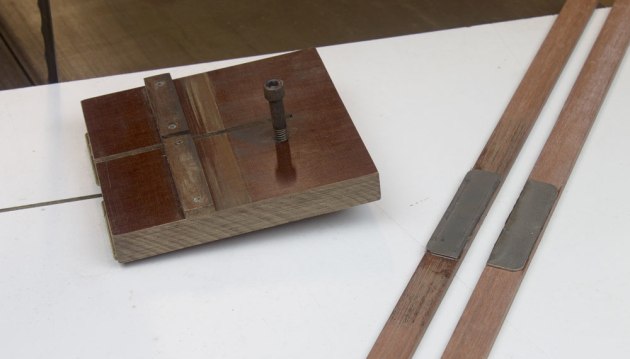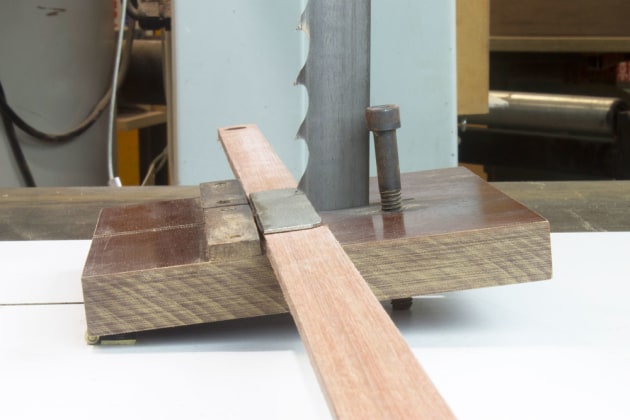Sharpening Your Bandsaw Blades
Words and photos: Darren Oates
In 2008, when I was undertaking my Certificate IV at Sturt School for Wood, the late Tom Harrington, then head instructor, told me about Lenox Woodmaster CT carbide tipped bandsaw blades. They were three times the cost of the high steel blades I was using, however Tom assured me carbide tipped blades would last at least three times longer.
I do a lot of curved laminations – they are in just about every piece of furniture I make – however the biggest advantage of changing over to this new blade was its very small kerf of 1.3mm compared to the high speed steel blade of around twice that at least and with a much rougher cut. This meant getting many more laminations from a set width piece of timber.
When I bought the blade I was told that it couldn’t be resharpened as the carbide tips were too small. Me being me thought that there had to be some way of sharpening and therefore extending its life.
I knew that being carbide tipped a diamond stone would have to be used, so all I had to do was make a jig that would hold this to the face of the blade at a constant angle, so the jig in these photos is what I came up with.
I purchased a DMT 3" DiaSharp – Coarse credit card sized diamond stone from Carbatec which was wide enough to make a pair of sharpening stones for these blades.
Photo 1: The underside of the jig is a simple affair using a piece of laminated particle board with hardwood on the edges to lock it onto the saw table – of course you can use any sort of substrate that you have lying around your workshop.
To fix the base into the correct position I fitted a piece of hardwood onto the underside that would sit into the bandsaw mitre track. I then marked a line where the blade would be and cut this on my panel saw so the jig could envelope the bandsaw blade.
Photo 2: The adjustable sub-base is mounted onto a pair of hinges to hold the sub base with no sideways movement. I then drilled and threaded a hole for a bolt to adjust the angle of the sub-base to match the face of the blade tooth. Use something durable for the sub-base as the track for the stone to slide back and forth in will wear otherwise. I had a scrap of bakelite and used that. This was sawn in the middle to envelop the blade.
Photo 3: The top face of the sub-base has a hardwood fence that the diamond stone sits against. The bolt is adjusted to the correct angle to match the face of the tooth. The diamond stone was cut in two with a grinder and then epoxied onto hardwood strips that were machined to slide on the sub-base in between the blade and the fence.
Cutting the diamond stone into this gives four cutting surfaces from the one stone as you can turn the hardwood strip around to use both edges. When cutting the stone, which is diamond particles bonded to a metal card, take your time and don’t try to cut it in one go. If you induce too much heat into the metal card you could heat up the bonding material for the diamond particles. I used a 1mm cutting disk induce less heat than a wider one, and took about five minutes to completely cut through the metal card. At no stage did the card get hot to the touch.
Photo 4 shows the relationship between the face of the blade tooth and the diamond stone once the correct angle has been set on the sub base. Once this angle is set you won’t need to adjust it again unless for different blades.
To use the jig, I mark a starting point on my blade and then while pulling the blade down onto the diamond stone, I slide it back and forth about five or six times to touch up the tooth. It takes about half an hour to touch up all the teeth on my blade for my 24" bandsaw, and then it cuts like a new blade again.
By making this simple jig I have greatly extended the life of these fantastic blades and saved a lot of money in the process.
Darren Oates is a studio furniture maker in NSW, learn more at www.darrenoatesfinefurniture.net







